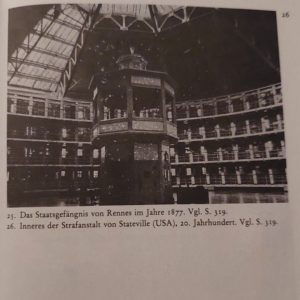“A prison machine with a vision cell is to be constructed, in which the prisoner is like in “a glass house of the Greek philosopher” finds trapped and with a center point, from which a constant gaze can control both the inmates and the staff. Various variations are possible around these two requirements: Bentham's Panopticum in its strict form, the semicircle, the cruciform plan or the star-shaped arrangement. In the midst of all these discussions, the minister recalled 1841 to the basic principles: ‘”The central inspection room is the hub of the whole system. Ohne zentralen Inspektionspunkt ist die Überwachung nicht mehr gesichert, steady and general, because it is impossible, full confidence in the job, to set the zeal and intelligence of the overseer over the cells … the architect must therefore focus all his attention on this goal, with which both the discipline and the economy are at stake. The more accurate and easier the monitoring is, all the less need we seek in the power of the buildings for guarantees against escape attempts and against associations among the prisoners. The surveillance will be perfect, when the warden or superintendent, without changing position and without being seen, sees not only the entrance to all cells and, with the door open, even the interior of most cells, but also the supervisors, who are responsible for guarding the prisoners on all floors. Mit dem Modell der kreisförmigen oder halbkreisförmigen Gefängnisse scheint es möglich, von einem einzigen Zentrum alle Häftlinge in ihren Zellen sowie die Wächter in ihren Überwachungsgalerien zu sehen.”‘
(Ducatel, instructions pour la construction des maisons d’arret, Michel Foucault, Monitoring and Penalties, 1977, Kapitel IV, Gefängnisse, totale und asketische Institutionen)

